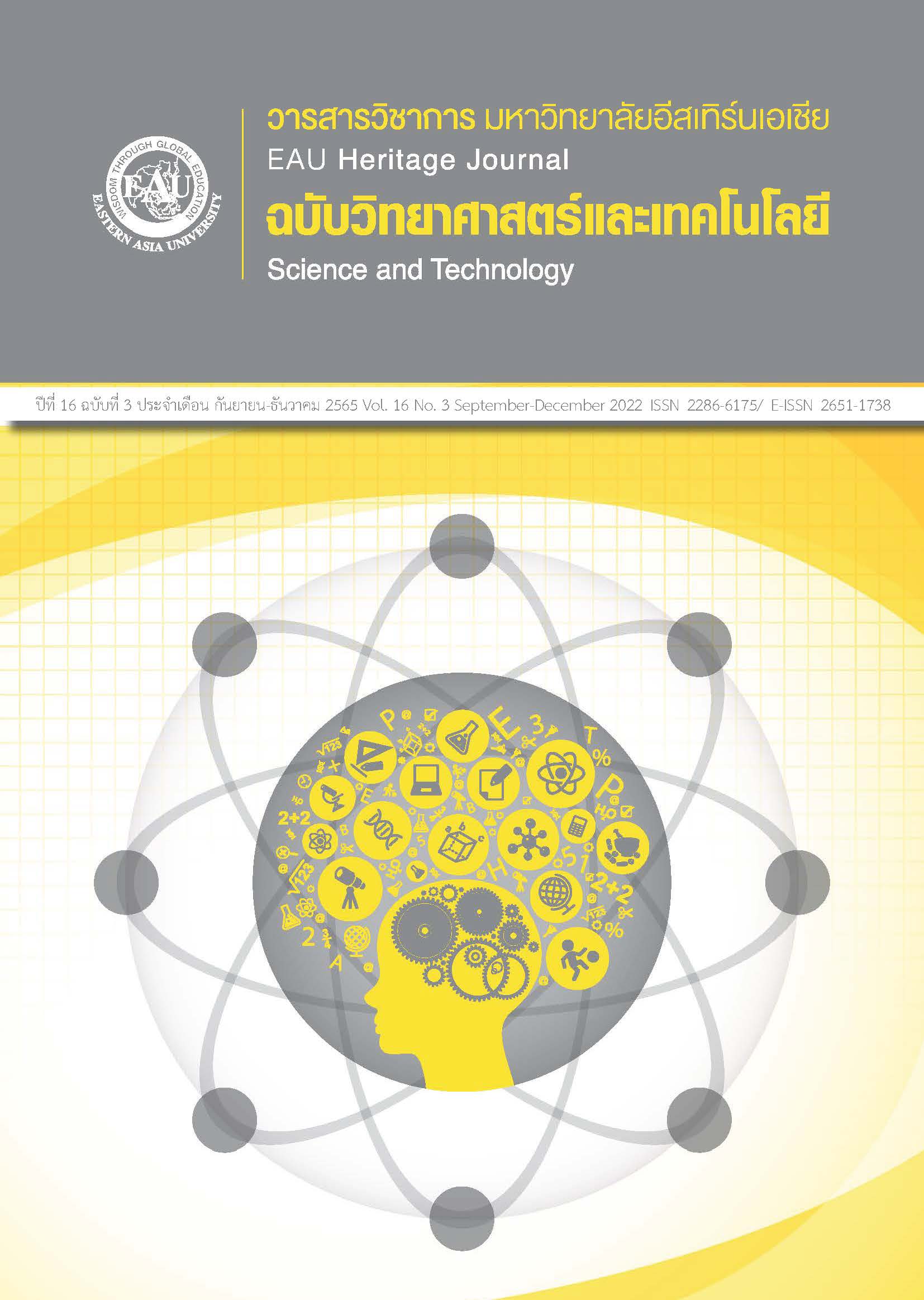ผลของการใช้ตัวกรองซ้ำในการถ่ายโอนมวลสารที่มีขนาดโมเลกุลต่างกัน ผ่านเยื่อกรองในกระบวนการฟอกเลือดด้วยเครื่องไตเทียม
คำสำคัญ:
การฟอกเลือดด้วยเครื่องไตเทียม, การใช้ตัวกรองซ้ำ, กระบวนการแพร่, การกำจัดสารออกจากไตบทคัดย่อ
การวิจัยนี้เป็นการวิจัยเชิงทดลองของกระบวนการถ่ายโอนมวลสารผ่านตัวกรองในกระบวนการฟอกเลือดด้วยเครื่องไตเทียมมีวัตถุประสงค์เพื่อศึกษาผลของการใช้ตัวกรองสำหรับฟอกเลือดซ้ำโดยใช้สารทดสอบที่มีขนาดโมเลกุลแตกต่างกันในการพิจารณาประสิทธิภาพการกรองสารผ่านเยื่อกรองโดยประเมินจากค่าการกำจัดสารออกจากไต (clearance) การทดลองจะใช้สารทดสอบเป็นสารละลายยูเรียและสารละลายมอลโตเดกซ์ตรินแทนการใช้เลือดจริง ส่วนน้ำ Reverse Osmosis--RO ใช้เป็นของเหลวทดสอบแทนน้ำยาฟอกเลือด (dialysate) โดยสารทดสอบและน้ำ RO พิจารณาให้ไหลเข้าสู่ตัวกรองในทิศทางเดียวกัน กำหนดให้อัตราการไหลของสารทดสอบมีค่าคงที่เท่ากับ 300 ml/min ในขณะเดียวกันปรับอัตราการไหลของน้ำ RO จนกว่าจะให้ผลต่างความดันระหว่างของไหลทั้งสองชนิดนี้น้อยที่สุด อุปกรณ์หลักที่ใช้ในการทดลองคือตัวกรองสำหรับฟอกเลือดที่แตกต่างกัน 3 ชนิด ได้แก่ ตัวกรอง FINEFLUX FIX-210S eco, ELISIO-210HR และ PEPA FDY-21B โดยตัวกรองเหล่านี้ผ่านการฟอกเลือดจากผู้ป่วยที่เป็นโรคไตเรื้อรังมาแล้วจำนวน 0 1 3 5 และ 7 ครั้ง ผลการวิจัยพบว่าเมื่อจำนวนการใช้ตัวกรองซ้ำเพิ่มมากขึ้น ตัวกรองทั้งสามชนิดมีแนวโน้มความเข้มข้นของสารละลายยูเรียลดลงส่งผลให้แนวโน้มโดยรวมของ Urea clearance เพิ่มขึ้น ในขณะที่แนวโน้มความเข้มข้นและ Clearance ของสารละลายมอลโตเดกซ์ตรินให้ผลตรงกันข้ามกับสารละลายยูเรีย ทั้งนี้พบว่าตัวกรอง FINEFLUX FIX-210S eco เป็นตัวกรองที่มีประสิทธิภาพในการกรองอนุภาคสารเหล่านี้ออกไปได้สูงกว่าตัวกรองอื่นโดยผลที่ได้นั้นสอดคล้องกับลักษณะพื้นผิวเยื่อกรอง อย่างสมเหตุสมผล แม้ตัวกรองจะผ่านการใช้งานซ้ำมาแล้วถึง 7 ครั้งแต่ยังคงมีประสิทธิภาพในการกรองสารได้ดีและสามารถนำตัวกรองไปใช้ซ้ำต่อได้
เอกสารอ้างอิง
Azar A. T. (2009). Increasing dialysate flow rate increases dialyzer urea clearance and dialysis efficiency: An in vivo study. Saudi Journal of Kidney Diseases and Transplantation: An Official Publication of The Saudi Center for Organ Transplantation, Saudi Arabia, 20(6), 1023–1029. https://www.sjkdt.org/text.asp?2009/20/6/1023/57258
Baker, R.W. (2012). Membrane technology and applications. New Jersey: John Wiley & Sons, Ltd. doi:https://doi.org/10.1002/0470020393.
Barreto, F., Barreto, D., & Canziani, M. (2017). Uremia retention molecules and clinical outcomes. Contributions to nephrology, 191, 18-31. doi:10.1159/000479253
Basile, C., Libutti, P., Teutonico, A., & Lomonte, C. (2010). Tossine uremiche: il caso dei “protein-bound compounds” [Uremic toxins: the case of protein-bound compounds]. Giornale italiano di nefrologia:Organo ufficiale della Societa italiana di nefrologia, 27(5), 498–507. http://www.nephromeet.com/web/eventi/GIN/dl/storico/2010/5/498-507.pdf
Biology Libretexts. (2022). Passive transport-diffusion. Retrieved from https://bit.ly/3UFcxII
Chang, K. Y., Kim, S. H., Kim, Y. O., Jin, D. C., Song, H. C., Choi, E. J., . . . Kim, Y. K. (2016). The impact of blood flow rate during hemodialysis on all-cause mortality. The Korean Journal of Internal Medicine, 31(6), 1131-1139. doi:10.3904/kjim.2015.111
Eloot, S., De Wachter, D., Van Tricht, I., & Verdonck, P. (2002). Computational flow modeling in hollow-fiber dialyzers. Artificial Organs, 26(7), 590–599. https://doi.org/10.1046/j.1525-1594.2002.07081.x
Eloot, S. (2004). Experimental and numerical modeling of dialysis (Doctoral dissertation). Ghent University. Belgium.
Glassock, R. J. (2008). Uremic toxins: What are they? An integrated overview of pathobiology and classification. Journal of Renal Nutrition, 18(1), 2-6. doi:10.1053/j.jrn.2007.10.003
Hemodialysis Clinical Practice Recommendation. (2014). The nephrology society of Thailand. Bangkok: Hemodialysis Clinical Practice Recommendation. (in thai)
Islam, M., & Szpunar, J. (2013). Study of dialyzer membrane (Polyflux 210H) and effects of different parameters on dialysis performance. Open Journal of Nephrology, 03, 161-167. doi:10.4236/ojneph.2013.33029
Ledebo, I., & Blankestijn, P. J. (2010). Haemodiafiltration-optimal efficiency and safety. NDT plus, 3(1), 8–16. https://doi.org/10.1093/ndtplus/sfp149
Leypoldt, J. K., Cheung, A. K., Agodoa, L. Y., Daugirdas, J. T., Greene, T., & Keshaviah, P. R. (1997). Hemodialyzer mass transfer-area coefficients for urea increase at high dialysate flow rates. The Hemodialysis (HEMO) Study. Kidney International, 51(6), 2013-2017. doi:10.1038/ki.1997.274
Nikkiso. (2016). Hollow fiber dialyzers PEPA FD-Series. Retrieved from http://nikkisomedical.com/wp-content/uploads/2017/06/pepa_EN_ausgabe2016-04_vers4pkt3.pdf
Nipro. (2018). Fineflux Fix-210S eco. Retrieved from https://www.info.pmda.go.jp/downfiles/md/PDF/530100/530100_22600BZX00004000_A_01_03.pdf
Nipro. (2018). ElisioTM. Retrieved from https://www.nipro-group.com/sites/default/files/2019-12/Elisio%20%20New%20Layout%20-%20EN%20-%2013Dec2018%20-%20Approved_Original_413.pdf
Palmer, S. C., Rabindranath, K. S., Craig, J. C., Roderick, P. J., Locatelli, F., & Strippoli, G. F. (2012). High-flux versus low-flux membranes for end-stage kidney disease. The Cochrane Database of Systematic Reviews, 2012(9), CD005016. https://doi.org/10.1002/14651858.CD005016.pub2
Raharjo, Y., Zainol Abidin, M. N., Ismail, A. F., Fahmi, M. Z., Saiful, Elma, M., . . . Habibi, A. R. (2022). Dialysis membranes for acute kidney injury. Membranes, 12(3), 325. https://www.mdpi.com/2077-0375/12/3/325
Ruangchai, K. (2021). Renal failure with challenges in health promotion. Journal of Safety and Health, 14(2), 1-14. (in thai)
Srisuwan, W., Charoensri, S., Jantarakana, K., & Chanchairujira, T. (2022). Increasing dialysate flow rate over 500 ml/min for reused high-flux dialyzers do not Increase delivered dialysis dose: A prospective randomized cross over study. Siriraj Medical Journal, 74(3), 152-160. doi:10.33192/Smj.2022.19
Thanakitjaru, P. (2014). Chronic Kidney Disease: CKD (Research report). Nonthaburi: Department of Medical Services. (in thai)
The National Kidney Foundation. (2005). What you should know about dialyzer reuse. Retrieved from https://www.kidney.org/sites/default/files/docs/dialyzer_reuse.pdf
The Nephrology Society of Thailand. (2022). Statement on single-use dialyzer for hemodialysis in end-stage chronic kidney disease patients. Retrieved from https://citly.me/W2raC. (in thai)
Tungkasereerak, P. (2008). Hemodialysis in hospitalized end state renal disease patients at Surin Hospital. Medical Journal of Sisaket Surin Buriram Hospital, 23(3), 639-648. (in thai)
Vadakedath, S., & Kandi, V. (2017) Dialysis: A review of the mechanisms underlying complications in the management of chronic renal failure. Cureus, 9(8), e1603. doi:10.7759/cureus.1603
Vanholder, R., Gryp, T., & Glorieux, G. (2017). Urea and chronic kidney disease: the comeback of the century? (in uraemia research). Nephrology Dialysis Transplantation, 33(1), 4-12. doi:10.1093/ndt/gfx039
Yamashita, A. C., Fujita, R., Tomisawa, N., Jinbo, Y., & Yamamura, M. (2009). Effect of packing density of hollow fibers on solute removal performances of dialyzers. Hemodialysis International. International Symposium on Home Hemodialysis, 13(Suppl 1), S2–S7. https://doi.org/10.1111/j.1542-4758.2009.00411.x







